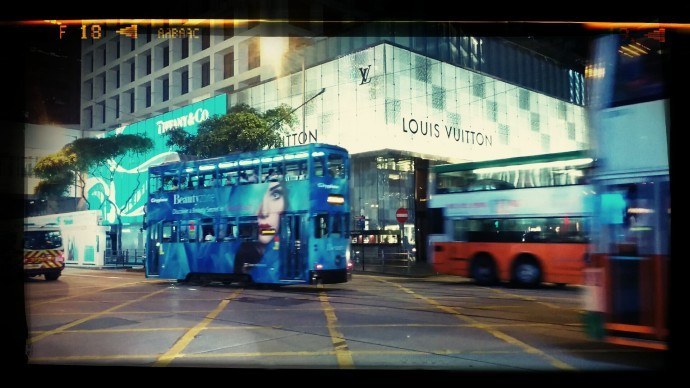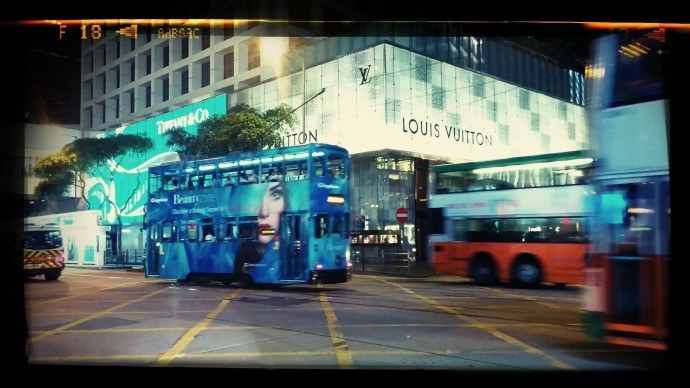
Thoughts On Nine Days In 12 Time Zones Ahead
June 10, 2014 by Dave Haynes

If you want a good sense of how this industry is or will be going through massive disruption, seize on the opportunity – like I just did – to go to Asia.
You’ll see what happens when everyone has broadband and digital payments are common. You’ll see what happens when 100s of companies are all making the same thing. And you’ll see how strategy still needs to drive any visual project.
I am back at the spare bedroom/live bait shop/world HQ this morning after nine days in Hong Kong and Taipei – finished with meetings, tours, demos, dinners and the one 30-minute speech that took me over there.
I spoke about a lot of things – mostly content and product marketing – to a big crowd of people involved in various ways in Taiwan’s tech and digital signage sector. I did not, really, get much into disruptive technology. Going down that path would have got me a lot of “Well, Duh?” looks.
When you live in North America it’s really easy to think that this is where it all happens and assume the state of the art is all around us.
No.
Consider my experiences in the Hong Kong and Taipei subway systems. I’d look around, and see no end of people watching streaming video on their smartphones, AS the subway cars were zipping along in the tunnels. I’d check the bars on my phone and see I had full signal on mine, no matter where I was above ground or below.
When I checked into my room in Taipei, I didn’t look for the hotel’s general WiFi router. There was one for my room. They had routers by the room and they just worked.
Digital payments are common and across industries. If you had an Octopus card in Hong Kong you could tap to use the MTR rail system, get on a bus, buy something at 7-Eleven (which are everywhere) or use a vending machine.
Absolutely everyone has a phone with a very high-speed connection and their faces are buried in them almost non-stop. I had to holler at people a few times as they barrelled at me on sidewalks and in subway passages, too consumed with their screens to consider looking ahead as they walked. There is a no way a digital OOH network operator could suggest they have a captive audience.
Walking Computex for a couple of days made it clear anyone looking to put tablets into retail environments as shelf-edge screens will have no end of choices. Because there are sooooo many manufacturers cranking out what amounts to the same thing, I saw a lot of stuff where different things were bing put together – to set them apart. So you could imagine things like an 8-inch tablet that had an NFC reader and fingerprint scanner.
I did a series of meetings while in Taipei, and what struck me there is that while that country is known much more for its hardware manufacturing (from the likes of Acer, Asus, Advantech, iBase, Lanner, Via, Viewsonic and on and on), there;s a shift happening. Tablets and phones have seriously eroded the PC market, so you have many of the companies above taking new approaches.
Aopen has an impressive retail innovation lab and offers software solutions. Via Technologies has a digital signage CMS, video wall solutions and does retail digital signage project integration in the region. Advantech’s new building in suburban Taipei is a working lab showing everything from a very slick meeting room booking and display system to energy management visualizations to a smart parking system that married LCDs, cameras and touch directories. All of Advantech’s stuff was built around sensors and embedded systems, and walked the talk around the whole Internet of Things premise.
All the companies I met with were looking beyond just moving units and wanting to offer suites of services that would help to offset eroding hardware sales.
A lot of the buzz in the last two years in this sector has been around low-cost Android-based devices. I talked to a number of people who suggested that while Intel and AMD may not fully get their own microprocessor costs down to that of the ARM devices that are in Android playback devices, costs are coming down and capabilities going up. It will be possible, it was suggested, for companies with Windows and Linux platforms to stick with them, and not adapt to Android.
Not being able to read or speak the local language (though you can easily get by with just English in Hong Kong) made it hard to sense how things are being marketed, but I saw little evidence of so-called omni-channel marketing. If there were ways to bridge phones to screens, I didn’t see it.
I also didn’t see all that much digital in retail or public environments, which surprised me. It all gets made in that region, but digital signage struck me as much more commonplace back home. It was around, certainly, but I saw little that made me stop to look or take photos.
One of my contacts suggested that the digital signage sector in the region is so heavily driven by engineering and manufacturing that the content and strategy sides of projects are weak or barely considered. It’s about the displays, and what drives them, instead of what’s on them.
Amazing stuff is coming out of that region, but from what I saw there is an amazing opportunity for companies in N. America and Europe to help the Asian market marry that great technology with equally great creative, and sold, fully-developed strategies.



Interesting Dave! thanks again for sharing 🙂
And what you said about the Octopus card in Hong Kong was true in the late ’90s. THAT’S how far behind we are here.